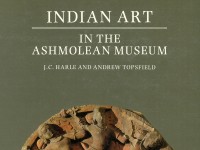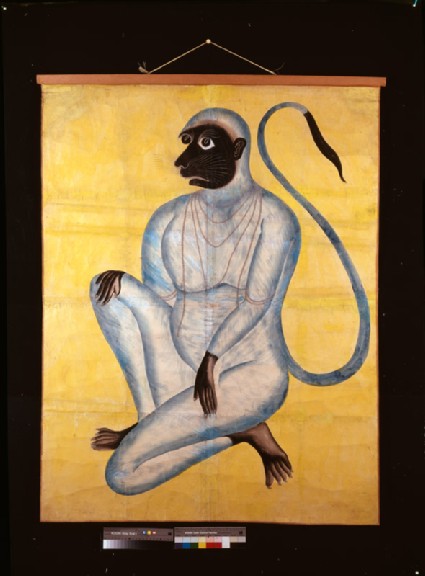Indian Art in the Ashmolean Museum
A catalogue of the Ashmolean’s collection of Indian art by J. C. Harle and Andrew Topsfield (published Oxford, 1987).

Publications online: 143 objects
- Reference URL
Actions
Hanuman, the monkey god
-
Literature notes
The work of the patua artists of eastern India, who produced narrative scrolls illustrating the religious epics for use by itinerant picture-showmen, was among the most vital forms of Indian folk painting in the 18th and 19th centuries, and probably much earlier. The Kalighat style is a distinctive urban variant of this ancient tradition. The Kālī temple which was built in 1809 at Kalighat, now in the southern suburbs of Calcutta, had quickly become a major pilgrimage centre. Shops and stalls near the temple made a brisk trade selling wood and clay dolls and images and brightly coloured paintings of the gods to visiting pilgrims. As the paintings were made to sell as cheaply as possible, they show a steadily increasing rapidity of execution. The flowing outlines of the figures were boldly accentuated by dark areas of wash in imitation of European modelling. The artists’ subject matter included not only gods and goddesses but satirical studies of modern, Westernised fashions and famous scandals of the day. In the later 19th century their work declined in the face of competition from mass-producede woodcuts and finally from the garish chromolithographic prints which are still found all over India today.
This painting of the monkey god Hanumān, the helper of Rāma and Sītā in the Rāmāyaṇa and one of the most popular Indian deities, is striking for its unusual size, equivalent to eight normal sheets of the paper used by Kalighat painters. It was possibily made as a special order for a European customer, as it formerly belonged to the London Missionary Society, for whom it may have served as a lecturing aid. (A similar painting form the same source in the Museum’s collection depicts Śiva as Ascetic and Musician.) Hanumān’s face, hands, feet and necklace are highlighted in silver and his body is pale blue, the paint streaked to represent fur; the background is yellow. The iconography is slightly unusual, as in this kneeling posture Hanumān is more often shown with hands raised to the chest, displaying the diminuitive figures of Rāma and Sītā enshrined in his heart. -
Details
- Associated place
-
Asia › India › east India › West Bengal › Kolkata › Kalighat (place of creation)
- Date
- c. 1870
- Material and technique
- gouache with silver on paper
- Dimensions
- 125 x 96 cm (height x width)
- Material index
- Technique index
- Object type index
- No. of items
- 1
- Credit line
- Purchased, 1966.
- Accession no.
- EA1966.183
-
Further reading
Harle, J. C., and Andrew Topsfield, Indian Art in the Ashmolean Museum (Oxford: Ashmolean Museum, 1987), no. 80 on p. 71, p. 70, pl. 12 (colour) & p. 71
Location
-
- currently in research collection
Objects are sometimes moved to a different location. Our object location data is usually updated on a monthly basis. Contact the Jameel Study Centre if you are planning to visit the museum to see a particular object on display, or would like to arrange an appointment to see an object in our reserve collections.
Publications online
-

Indian Art in the Ashmolean Museum
The work of the patua artists of eastern India, who produced narrative scrolls illustrating the religious epics for use by itinerant picture-showmen, was among the most vital forms of Indian folk painting in the 18th and 19th centuries, and probably much earlier. The Kalighat style is a distinctive urban variant of this ancient tradition. The Kālī temple which was built in 1809 at Kalighat, now in the southern suburbs of Calcutta, had quickly become a major pilgrimage centre. Shops and stalls near the temple made a brisk trade selling wood and clay dolls and images and brightly coloured paintings of the gods to visiting pilgrims. As the paintings were made to sell as cheaply as possible, they show a steadily increasing rapidity of execution. The flowing outlines of the figures were boldly accentuated by dark areas of wash in imitation of European modelling. The artists’ subject matter included not only gods and goddesses but satirical studies of modern, Westernised fashions and famous scandals of the day. In the later 19th century their work declined in the face of competition from mass-producede woodcuts and finally from the garish chromolithographic prints which are still found all over India today.
This painting of the monkey god Hanumān, the helper of Rāma and Sītā in the Rāmāyaṇa and one of the most popular Indian deities, is striking for its unusual size, equivalent to eight normal sheets of the paper used by Kalighat painters. It was possibily made as a special order for a European customer, as it formerly belonged to the London Missionary Society, for whom it may have served as a lecturing aid. (A similar painting form the same source in the Museum’s collection depicts Śiva as Ascetic and Musician.) Hanumān’s face, hands, feet and necklace are highlighted in silver and his body is pale blue, the paint streaked to represent fur; the background is yellow. The iconography is slightly unusual, as in this kneeling posture Hanumān is more often shown with hands raised to the chest, displaying the diminuitive figures of Rāma and Sītā enshrined in his heart.
Notice
Object information may not accurately reflect the actual contents of the original publication, since our online objects contain current information held in our collections database. Click on 'buy this publication' to purchase printed versions of our online publications, where available, or contact the Jameel Study Centre to arrange access to books on our collections that are now out of print.
© 2013 University of Oxford - Ashmolean Museum

